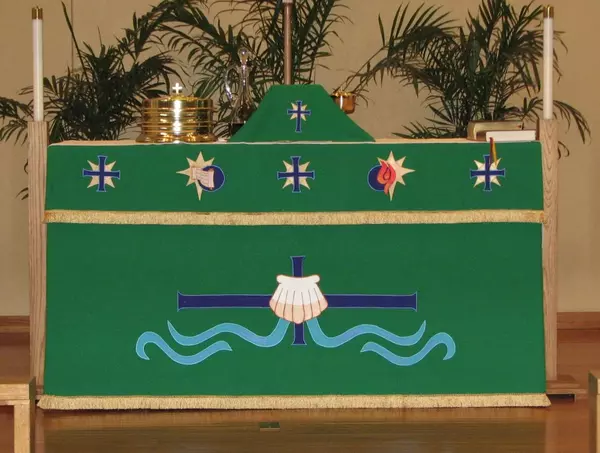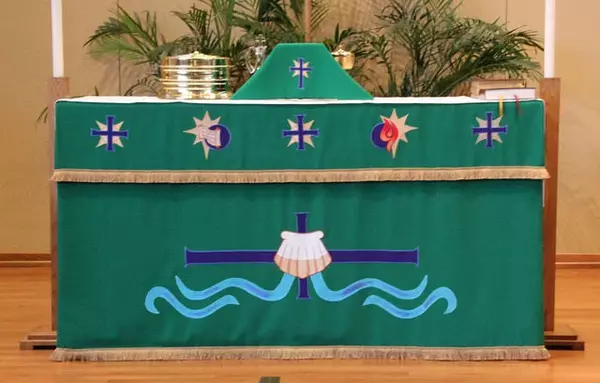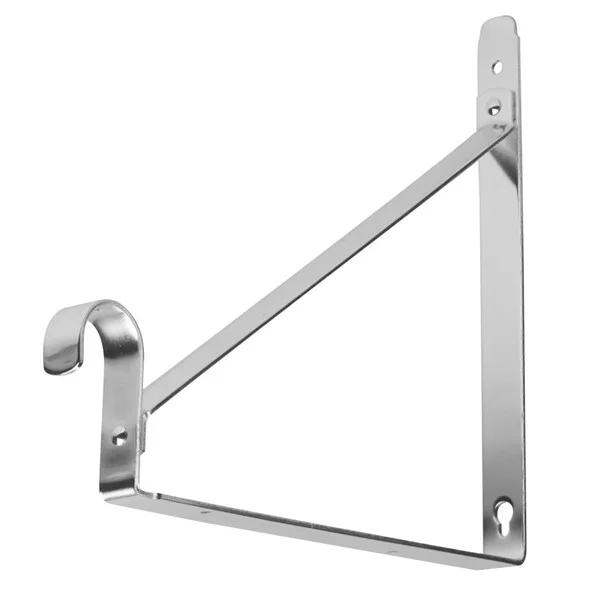The Ravages of Time on Ecclesiastical Vestments
The Ravages of Time on Ecclesiastical Vestments
There is a feeling of joy when a new set of Ecclesiastical Vestments is completed and used for the first time. That feeling can last for ages. And the care that is taken of both vestments and altar hangings can make that feeling last for a very long time. After all, making a set of liturgical altar hangings, a stole, or a chasuble involves not only an investment of money for material and supplies, it also a major investment of time. When we as individuals make items for our church, it is frequently done for love: “Amo” – the Latin for I Love, is a fitting explanation. I do this for love, as a way of thanking the Lord for the good gifts I have been given. I love to sew. I love making vestments for the church, and I love sharing what I have learned with others so they too can put their time and talent to work for the Lord’s House.
The vestment sets completed, or in the process of being made, have all been done at my expense. The cost soon adds up. And with a growing collection of beautiful altar hangings, and hopefully, a growing collection of matching vestments, the issue of storage must be addressed to properly care for these items.
First Used

In looking back through photos today, I noticed this one of the green altar frontal and superfrontal. The photo was taken in August 2012. As of now, the set had been in use for two years, but not much longer. But what is striking is that everything is “board” flat. The fabric is taunted, the color is fresh, and there are no wrinkles or sags.
Two years of used

Here is an updated photo taken of the same altar frontal in the summer of 2014. Notice the deterioration that has happened in only two years. It is almost heartbreaking.
What has happened to this frontal, and why? Several contributing factors have resulted in the dramatic change in the green altar frontal. The first I suspect has to do with long-term storage when the frontal is not in use. Our church is tiny, and there is a lack of appropriate storage for everything, including these beautiful altar frontals. The storage solution decided upon by the members who were trying to be helpful was to drape the frontal over a piece of heavy PVC plastic piping.
Shelf Bracket

Next, they took a shelf bracket, turned it upside down as in the above photo, and mounted that to the wall. The PVC tubes with the frontals are suspended between the two brackets and left to hang. There are some sheets available to protect the pieces from dust. The Sacristy is not used except on Sundays; light is not an issue while items are stored. The idea is a nice one, and it is good from the standpoint that the altar frontals are not wrinkled with this method of storage.
The Challenges in Maintaining Appearance
The problem comes with the continual hanging. The fabric is constantly in a state where gravity plays upon it, pulling it down. These frontals are wide at 72″, but not nearly as wide as they might be if they were from a Grand Cathedral. But they are wide enough, that being left to constantly hang, the opportunity exists for them to start sagging.
The ideal storage would be large flat drawers where the altar frontals would be placed flat, without hanging. Think of a beautiful sweater, or other fashion items, where it is always best to leave the item folded flat, rather than hanging the garment to avoid distortion.
The second problem that has attacked this frontal is the summer sun. I noticed something odd when the green set was pulled out and used during those few short weeks between Epiphany and the start of the Lenten season. It took a while to figure out the problem. The stole used by Pastor was looking fresh and lovely as always, but the altar frontal was not looking quite so nice. And then, the answer appeared as the sun beamed through the windows on a gloomy day: sun fading.
This green altar frontal is in use for the greater part of the church year, over the entire summer season. The altar gets the direct effect of the summer sun from high, southern-facing windows. Day in and day out, the altar frontal is in direct sunlight for 8 to 10 or more hours. Sunlight is a dreaded enemy of liturgical vestments, along with dust.
The issue of direct sun may be resolved or at least somewhat minimized. Just this past week, stained glass windows were installed, which might assist with diffusing the direct southern exposure on the altar frontal, minimizing or slowing future fading and sun damage.
The third problem is most likely the fabric used in making the altar frontal. The fabric, a wool crêpe, has a soft hand, and the crêpe weave is not a firm, solid weave, which again may be a contributing factor to the sagging issue. At the time, the fabric was the only thing available in a price range that was affordable to make a set of green altar hangings.
I still like wool crêpe, and if the fabric were available, I would use it for a vestment set that was used one or two times during the church year, and not for a set used so heavily. The wool crêpe is a lovely fabric to use for vestments, but the nature and character of the fabric must be taken into account and used for the best advantage. If I were to use any wool fabric in the future, I would consider having the fabric steam shrunk at a dry cleaner before beginning any construction: things we learned years ago in tailoring, before pad stitching a jacket, that has been forgotten over time…… and now resurface.
But what can be done about the dramatic changes to the altar frontal? At this point in time, I am not sure. It was not a terribly expensive set to make, so it is not the end of the world if, at some point in time, the set is retired. But my time is also limited and making a new set of green vestments would take time. The ideal situation would be to have 2 or 3 sets of green that could alternate throughout the church year, as green is used most often. That will not be happening soon, so the alternative is that the green altar frontal set will have to come home and be disassembled. The fabric will have to be steamed and tightened up, testing to ensure it will not ruin the machine appliques. Then the altar frontal will have to be reassembled.
Other options: I could keep this set at home as I do the black Vestments and rose vestment set, but that would be difficult, as it is used so often during the church year. There are times when it is used one week, off for a few, and back on, making it too impossible for me to keep track of, and to remember to have it at church when needed.
Suggestions were made to create flat storage options in an upstairs storage room at church, but many of those on the altar guild are a little older, and getting up and down the steep stairs to the storage room would be a challenge. Add the reality of carrying these heavy frontals, and the option is out.
Leaving the frontal out anyplace else in the building, stored flat is asking for disaster and certain damage of a worse nature.
Flat storage would be ideal, but it will not happen shortly, so until then, the only alternative is to make the repairs and plan a new set from a different material that will not be so prone to sagging.
I am very fortunate that we have a caring congregation who appreciates the lovely vestments and is willing to find storage solutions to properly care for these Ecclesiastical Vestments.
Solo Dei Gloria
Be sure to visit our online store front Ecclesiastical Sewing where you may shop for Liturgical Fabrics, altar linen fabrics, church vestment-making patterns, liturgical machine embroidery designs, church vestment trims and notions and so much more. You may also find us on Ecclesiastical Sewing on Facebook, Twitter, and Pinterest. Sign up for our mailing list at the bottom of the page on our online store front and receive a free copy of our Small Linens Booklet as our way of saying thank you for following along.
Quatrefoil Ecclesiastical Design – Part 2
Advent Altar Hanging and Pulpit Fall Ideas
Planning – First Steps for Altar Frontal
Progress on Ecclesiastical Embroidery
Black Passion Cross Update
Gothic Chasuble Sewing Pattern Fabric Options






 RSS - Posts
RSS - Posts
I made a set of 12 foot long dossals for my last church. Obviously, with a hanging so long and heavy, hanging them up or folding them would quickly lead to damage. We wound up rolling the large hangings on PVC pipe cut to the width of the hanging. The rolled hangings were then placed in a zippered cotton king size pillow protector, which was labeled with the color and season of the hanging. Finally, at a local thrift store, I was able to find an old oak cabinet with doors that locked that was part of a set of storage cabinets, and was able to purchase the cabinet for less than the cost of one set of hangings. The PVC pipe prevents the rolls from being crushed into folds. The cotton bags keep out light and dust.
The storage solution for your beautiful altar frontals may just be rolling them up and placing them in a storage chest, rather than hanging them. Who knows, you may be able to find an old cedar chest or an old oak cabinet somewhere at a thrift store.
Thank you for the great idea! Rolling the frontals on PVC pipe might work out well. The altar guild will have to take care in rolling to ensure no creases are rolled in. It will certainly prevent the continual re-ironing of the sets I have to take home and bring back. I think you have just given me an idea that might work for storage as well….. I will try to do a post soon. Thank you for the great suggestion.